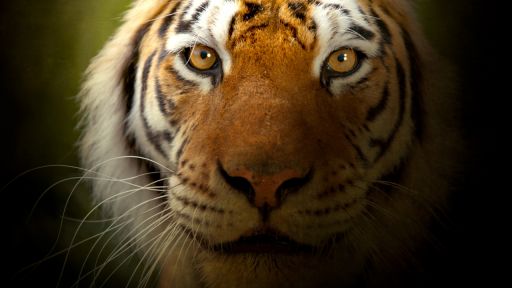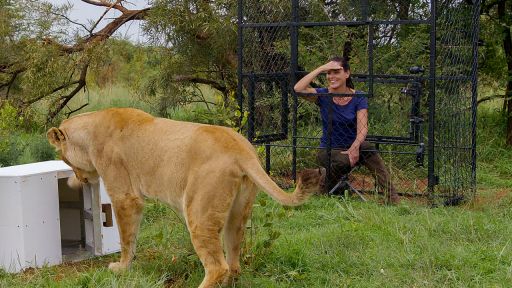In part three of NATURE’s miniseries “Super Cats,” scientists are studying cats in greater detail than ever before. New approaches and technologies help uncover some of the cats’ most intimate secrets, including the cheetah’s remarkable gymnastic abilities and why lions are able to hunt so cooperatively. Conservationists are fighting to protect the most endangered species around the globe, such as the Iberian lynx, once considered the rarest cat on the planet.
Super Cats: Episode 3 | Science and Secrets
Scientists are studying cats in greater detail than ever before. New approaches and technologies help uncover some of the cats’ most intimate secrets, including the cheetah’s remarkable gymnastic abilities and why lions are able to hunt so cooperatively.
Features
Narrated by
F. MURRAY ABRAHAM
Produced & Directed by
GAVIN BOYLAND
Photography
STUART DUNN
Sound
ZUBIN SAROSH
Additional Photography
SIMON ENDERBY
SUE GIBSON
DAVID LOUGEDO
JOSÉ LUIS ROUCO FERNANDEZ
KALYAN VARMA
VISUAL AIR PRODUCTIONS
Additional Sound
NICK ALLINSON
ELLIE WILLIAMS
Film Editor
NICK CARLINE
Edit Producer
GILLIAN TAYLOR
Assistant Film Editor
JACK ROBERTS
Post Production
DOGHOUSE POST PRODUCTION
WOUNDED BUFFALO
Graphic Design
BDH CREATIVE
Sound Editor
JONNY CREW
Dubbing Mixer
BEN PEACE
Colorist
FRED TAY
Online Editor
MICHAEL LANSDELL
Original Music
BLEEDING FINGERS
Score Producers
MONICA SONAND
RUSSELL EMANUEL
Scientific Consultants
Dr ALEXANDER SLIWA
Dr LUKE HUNTER
Special Thanks
TATJANA HUBEL
SABAH PARKS DEPARTMENT
LE PARC DES FÉLINS
UNIVERSITY OF MUHAMMADIYAH, PALANGKA RAYA
Archive
BORNEO NATURE FOUNDATION
SHANSHUI/PANTHERA/SLT/SEEF/GZC
Wildlife Permits Provided by
JUNTA DE ANDALUCÍA
JUNTA DE EXTRAMEDURA
MINISTRY OF ENVIRONMENT AND FORESTS, INDIA
Director
SARA DOUGLAS
Researchers
ANNA PLACE
HARRIET LAWRENCE
LEAH ARNOLD-REDMAN
Production Coordinators
JO ARMSTRONG DAVIS
SUSANNA PROUSE
Production Team
ARPANA PATERSON
JANE ATKINS
GEORGE PILAS
SOPHIE EDWARDS
BECKY PAYNE
ESHIKA FYZEE
NATHALIE GALVE
ELLIE KYNASTON
Production Manager
STELLA STYLIANOS
Unit Manager
KATE GORST
Commissioning Editor
TOM MCDONALD
Series Producer
GAVIN BOYLAND
Executive Producer
MICHAEL GUNTON
For NATURE
Series Editor
JANET HESS
Senior Producer
LAURA METZGER LYNCH
Coordinating Producer
JAYNE JUN
Associate Producer
JAMES F. BURKE
Legal Counsel
BLANCHE ROBERTSON
Digital Producer
HEATHER TONER
Social Media Editor
KAREN HO
Audience Engagement
CHELSEY SAATKAMP
Budget Controller
JAYNE LISI
Online Editor
STACEY DOUGLASS MOVERLEY
Re-Recording Mixer
ED CAMPBELL
Original Funding Provided in Part by
The Arnhold Family In Memory Of Clarisse Arnhold
Sue and Edgar Wachenheim III
Kate W. Cassidy Foundation
Lillian Goldman Charitable Trust
Kathy Chiao and Ken Hao
Anderson Family Fund
Filomen M. D’Agostino Foundation
Rosalind P. Walter
The Halmi Family in memory of Robert Halmi, Sr.
Sandra Atlas Bass
The Arlene and Milton D. Berkman Philanthropic Fund
Anne Ray foundation
Corporation for Public Broadcasting
Series Producer
BILL MURPHY
Executive Producer
FRED KAUFMAN
A BBC Studios Production for PBS and BBC with THIRTEEN Productions LLC, co-produced by France Télévisions
This program was produced by THIRTEEN Productions LLC, which is solely responsible for its content
© 2018 BBC
SUPER CATS ADDITIONAL MATERIALS © 2018 PBS AND
© 2018 THIRTEEN PRODUCTIONS LLC
ALL RIGHTS RESERVED
NATURE's landmark, three-part series concludes.
It's a critical time for new research and cat conservation.
This is an age of discovery that's revolutionizing how we view this amazing superfamily.


